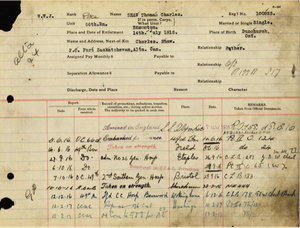SHAW, PTE THOMAS CHARLES - Regimental # 100825
Thomas Charles Shaw was born in Dunchurch August 22, 1894. His parents were Charles Thomas Shaw and Margaret Jane Buchanan. The family moved west, but in keeping with the theme of this book he is included here.
Thomas Charles Shaw enlisted July 14, 1915 in Edmonton. He arrived in England on the SS Olympic May 7, 1916 as part of 66nd Battalion. In June he joined the 49th Battalion in France.
The first note in his records comes from September 26, 1916 when he was reported seriously ill with a gunshot wound to his chest and was admitted to No 26 Gen. Hospital at Etaples
In fact, Thomas had been wounded at the Somme September 15, 1916. He was evacuated from France to England where he was treated for about 9 months. He was put in a clerical position in the Estates Branch until June 1, 1918 when he was sent back to his unit in France.
The wound which he received was described as follows: “Wound entrance immediately left of manubrium sternum. Wound exit one inch internal to posterior fold of left axilla at its summit. The bullet traversed the upper part of the left chest penetrating the upper lobe of left lung and fracturing left border of scapula on left side.
On August 8, 1919 Thomas Shaw arrived back in Canada. He was discharged Aug 25, 1919.
The Battle of the Somme is summarized as follows by Veterans Affairs Canada: “The Battle of the Somme began with a massive attack by hundreds of thousands of British and French troops on the morning of July 1, 1916. It would be a disastrous start for the Allies as their forces were pounded by heavy enemy fire when they climbed out of their trenches and advanced across No Man's Land. Tragically, more than 57,000 British Commonwealth troops would be killed, wounded, taken prisoner or go missing—the highest single day losses in the British Army's long history…The Battle of the Somme was not a one-day affair, however, and the offensive would continue for more than four and a half months. While the Allies did have some battlefield successes later in July, a major breakthrough never materialized and the bloody fighting dragged on…. For most of the summer of 1916, the Canadian Corps had been manning a section of the Western Front in Belgium. In late August, however, they began to shift to the Somme front near the French village of Courcelette. The Canadians immediately encountered some stiff action there and suffered some 2,600 casualties before the major new offensive they had been tasked with had even gotten underway. On September 15, our soldiers took part in a large-scale attack that was launched at dawn and pushed forward on a 2,000-metre wide front. Making use of a newly developed tactic called the creeping barrage, the Canadians advanced behind a carefully aimed wave of Allied artillery fire that moved ahead on a set schedule. This heavy bombardment forced the enemy defenders to stay under cover for protection and prevented them from cutting down the advancing troops with their rifle and machine gun fire. For this tactic to work, though, the soldiers had to stay perilously close to the heavy shellfire and many were wounded by the Allies' own artillery explosions….The attack went well and by 8:00 a.m., the shattered German defensive position known as the Sugar Factory was taken. The Canadians then pushed ahead to Courcelette itself which was captured later that day. The Germans did not relent, however, and launched numerous counter-attacks which our soldiers repulsed as they consolidated their newly won positions. As was often the pattern during attacks on the Western Front, however, the enemy soon brought up major reinforcements, the defences solidified and any further gains became incredibly hard.
The fighting would not yet come to an end on the Somme, though. In the weeks that followed, soldiers of the 1st, 2nd and 3rd Canadian Divisions would be repeatedly flung against a series of German entrenchments.”

















